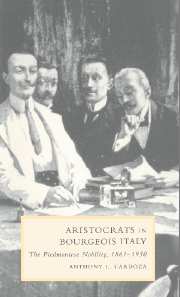Book contents
- Frontmatter
- Contents
- List of tables
- Acknowledgments
- Introduction
- 1 The making of the Piedmontese nobility: 1600–1848
- 2 The long goodbye: aristocrats in politics and public life: 1848–1914
- 3 Old money: the scale and structure of aristocratic wealth
- 4 Perpetuating an aristocratic social elite
- 5 The limits of fusion: aristocratic–bourgeois relations in nineteenth-century Piedmont
- 6 Retreat and adaptation in the twentieth century
- Bibliography
- Index
- CAMBRIDGE STUDIES IN ITALIAN HISTORY AND CULTURE
4 - Perpetuating an aristocratic social elite
Published online by Cambridge University Press: 03 November 2009
- Frontmatter
- Contents
- List of tables
- Acknowledgments
- Introduction
- 1 The making of the Piedmontese nobility: 1600–1848
- 2 The long goodbye: aristocrats in politics and public life: 1848–1914
- 3 Old money: the scale and structure of aristocratic wealth
- 4 Perpetuating an aristocratic social elite
- 5 The limits of fusion: aristocratic–bourgeois relations in nineteenth-century Piedmont
- 6 Retreat and adaptation in the twentieth century
- Bibliography
- Index
- CAMBRIDGE STUDIES IN ITALIAN HISTORY AND CULTURE
Summary
In the second half of the nineteenth century, Piedmontese aristocrats and their blue-blooded counterparts elsewhere on the Italian peninsula confronted a world in which many of the old social boundaries and barriers had been dismantled or blurred. With the disappearance of the absolute monarchy and the abolition of the last remnants of feudalism, nobles ceased to be members of a legally distinct order possessing any exclusive rights and prerogatives. Old-line families still had a legal right to sport their titles as symbols of their antiquity and to pass them from generation to generation, but these titles no longer afforded special privileges or significant economic advantages. Henceforth the prestige and influence of the nobility would have to rest chiefly on their status as a social elite.
The loss of privileges unavoidably raised, however, fundamental questions about what it now meant to be a noble and about the extent to which individual nobles still constituted a coherent group, separate from other elements of Piedmont's propertied classes. Once titles ceased to carry with them tangible and exclusive benefits, they also ceased to provide even the appearance of unity to an “estate” that, in fact, had always encompassed sizeable variations in wealth, origins, and family lineage.
- Type
- Chapter
- Information
- Aristocrats in Bourgeois ItalyThe Piedmontese Nobility, 1861–1930, pp. 126 - 161Publisher: Cambridge University PressPrint publication year: 1998



